Page 234 of 371
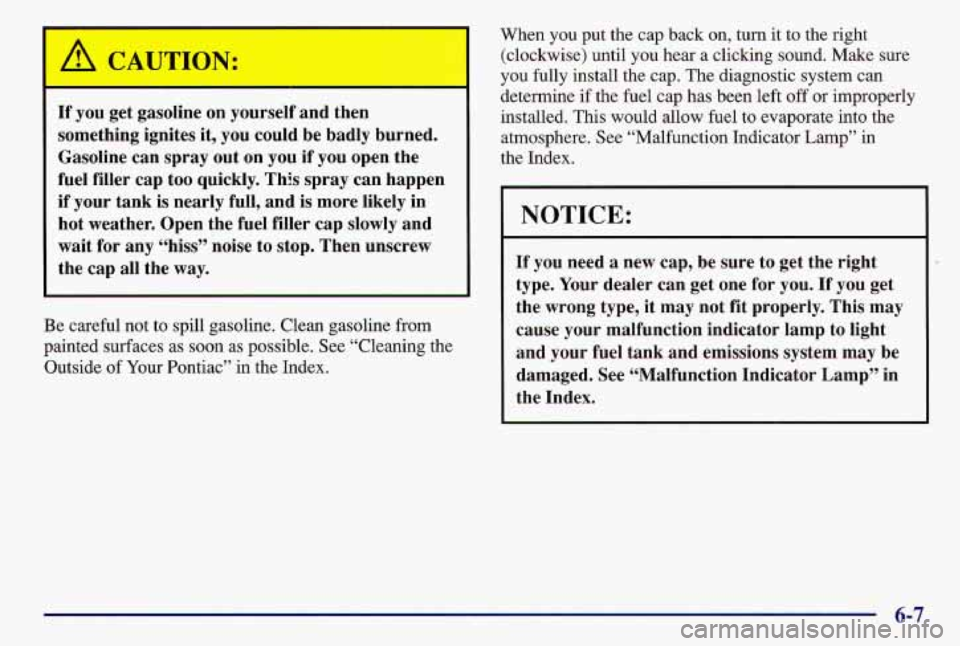
A CAUTION:
I=
If you get gasoline on yourself and then
something ignites it, you could be badly burned.
Gasoline can spray out on you
if you open the
fuel filler cap too quickly, This spray can happen
if your tank
is nearly full, and is more likely in
hot weather. Open the fuel filler cap slowly and
wait for any “hiss” noise to stop. Then unscrew
the cap all the way.
Be careful not to spill gasoline. Clean gasoline from
painted surfaces as
soon as possible. See “Cleaning the
Outside of Your Pontiac” in the Index. When you
put the cap back on, turn
it to the right
(clockwise) until you hear a clicking sound. Make sure
you fully install the cap. The diagnostic system can
determine
if the fuel cap has been left off or improperly
installed. This would allow fuel to evaporate into the
atmosphere. See “Malfunction Indicator Lamp” in
the Index.
NOTICE:
If you need a new cap, be sure to get the right
type. Your dealer can get one for you, If you get
the wrong type, it may not fit properly. This may cause your malfunction indicator lamp to light
and your fuel tank and emissions system may be
damaged. See “Malfunction Indicator Lamp” in
the Index,
6-7
Page 239 of 371
Engine Oil
CHECK
OIL
If your Pontiac is equipped
with the
3100 engine, there is
a CHECK
OIL light in your .
instrument panel cluster.
If the
CHECK OIL light on the instrument panel comes
on, it means you need to check your engine oil level
right away. For more information, see “Check Oil
Light” in the Index. You should check your engine oil
level regularly; this is an added reminder.
It’s a good idea to check your engine oil every time you
get fuel. In order to get an accurate reading, the oil must
be warm
and the vehicle must be on level ground.
2.4L Engine
6-12
Page 243 of 371
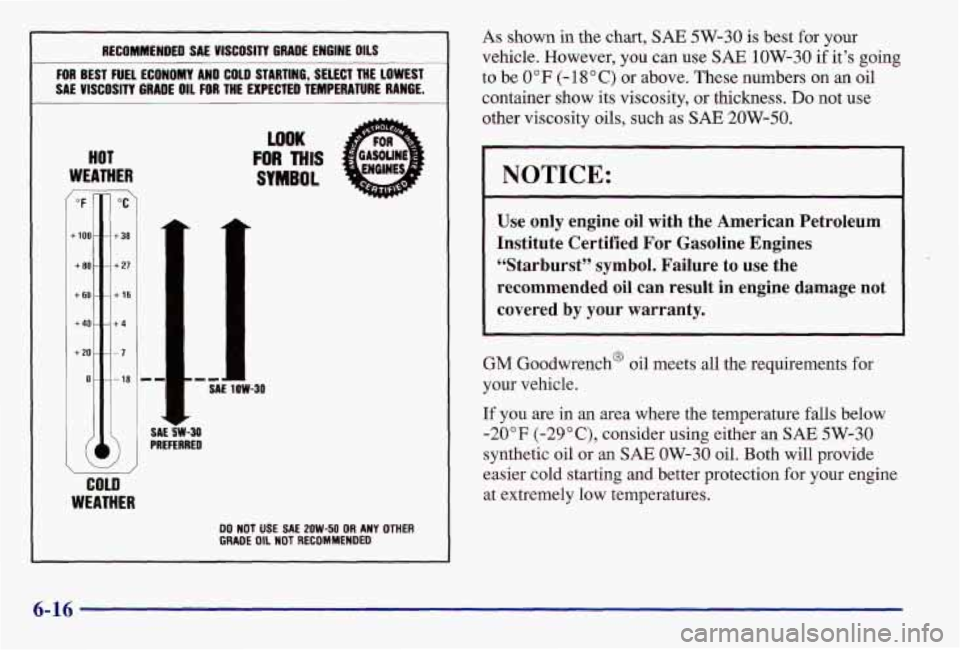
~ ~
~ ~~ RECOMMENDED SAE VISCOSITY GRAD€ ENGINE OILS
FOR BEST FUEL ECONOMY AND COLD STARTING, SELECT THE LOWEST
SAE VISCOSITY GRADE
011 FOR THE EXPECTED TEMPERATURE RANGE.
HOT
WEATHER
d
COLD
/
WEATHER
LOOK
FOR MIS
SYMBOL
SAE SW-M PREFERRED
DO NOT USE SAE 2OW-50 OR ANY OTHER
GRADE OIL NOT RECOMMENDED
As shown in the chart, SAE 5W-30 is best for your
vehicle. However, you can use
SAE 1OW-30 if it’s going
to be
0°F (- 18 ” C) or above. These numbers on an oil
container show its viscosity, or thickness.
Do not use
other viscosity oils, such as
SAE 20W-50.
NOTICE:
Use only engine oil with the American Petroleum
Institute Certified For Gasoline Engines
“Starburst” symbol. Failure to use the
recommended
oil can result in engine damage not
covered by your warranty.
GM Goodwrench@ oil meets all the requirements for
your vehicle.
If you are in an area where the temperature falls below
-20°F (-29”C), consider using either an SAE 5W-30
synthetic oil or an
SAE OW-30 oil. Both will provide
easier cold starting and better protection for your engine
at extremely low temperatures.
6-16
Page 269 of 371
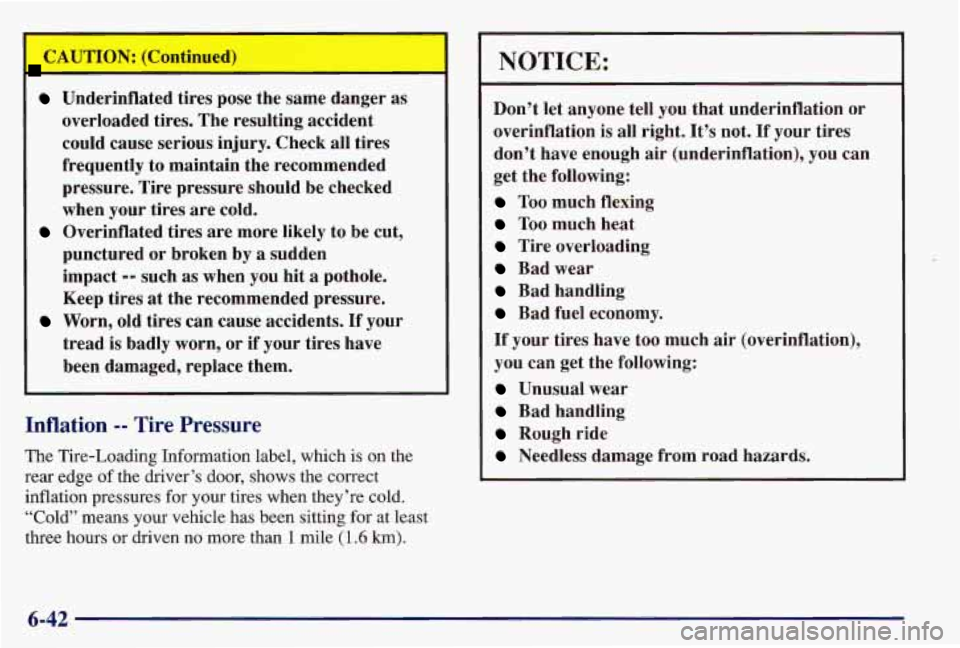
-
CAUTION: (Continued)
Underinflated tires pose the same danger as
overloaded tires. The resulting accident
could cause serious injury. Check all tires
frequently to maintain the recommended pressure. Tire pressure should be checked
when your tires are cold.
Overinflated tires are more likely to be cut,
punctured or broken by
a sudden
impact
-- such as when you hit a pothole.
Keep tires at the recommended pressure.
Worn, old tires can cause accidents. If your
tread
is badly worn, or if your tires have
been damaged, replace them.
Inflation -- Tire Pressure
The Tire-Loading Information label, which is on the
rear edge of the driver’s door, shows the correct
inflation pressures for your tires when they’re cold.
“Cold” means your vehicle has been sitting for at least
three hours or driven no more than
1 mile ( 1.6 km).
NOTICE:
~ ~~
Don’t let anyone tell you that underinflation or
overinflation is
all right. It’s not. If your tires
don’t have enough air (underinflation), you can
get the following:
Too much flexing
Too much heat
Tire overloading
Bad wear
Bad handling
Bad fuel economy.
If your tires have too much air (overinflation),
you can get the following:
Unusual wear
Bad handling
Rough ride
Needless damage from road hazards.
6-42
Page 283 of 371
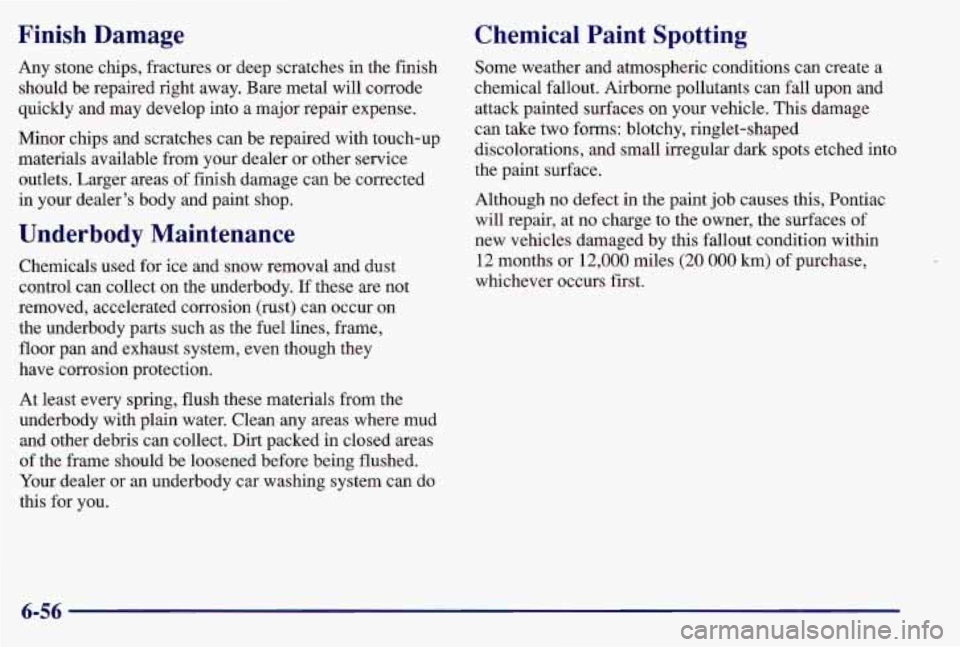
Finish Damage
Any stone chips, fractures or deep scratches in the finish
should be repaired right away. Bare metal will corrode
quickly and may develop into a major repair expense.
Minor chips and scratches can be repaired with touch-up
materials available from your dealer or other service
outlets. Larger areas of finish damage can be corrected
in your dealer’s body and paint shop.
Underbody Maintenance
Chemicals used for ice and snow removal and dust
control can collect on the underbody. If these are not
removed, accelerated corrosion (rust) can occur on
the underbody parts such as the fuel lines, frame,
floor pan and exhaust system, even though they
have corrosion protection.
At least every spring, flush these materials from the
underbody with plain water. Clean any areas where mud
and other debris can collect. Dirt packed in closed areas
of the frame should be loosened before being flushed.
Your dealer or an underbody car washing system can do
this for you.
Chemical Paint Spotting
Some weather and atmospheric conditions can create a
chemical fallout. Airborne pollutants can fall upon and
attack painted surfaces on your vehicle. This damage
can take two forms: blotchy, ringlet-shaped
discolorations, and small irregular dark spots etched into
the paint surface.
Although
no defect in the paint job causes this, Pontiac
will repair, at no charge to the owner, the surfaces of
new vehicles damaged by this fallout condition within
12 months or
12,000 miles (20 000 km) of purchase,
whichever occurs first.
6-56
Page 289 of 371
Engine Compartment Fuse Block
F/P,INJR I IGN MOD 1 L b1
ABSiEVO PCM BATT I
Fuse
F/P INJ
ERLS
The engine compartment fuse block
is located on the
driver’s side
of the engine compartment, near the battery.
ABSEVO
Usage
Fuel Pump, Fuel Injectors Back-up Lamps, Canister
Purge Valve, EGR, Automatic
Transmission, Brake
Transmission Shift Interlock,
Anti-Lock Brakes, Variable
Effort Steering, Air Conditioning Compressor, Park
Lock Solenoid
Anti-lock Brake Solenoids,
Variable Effort Steering
6-62
Page 291 of 371
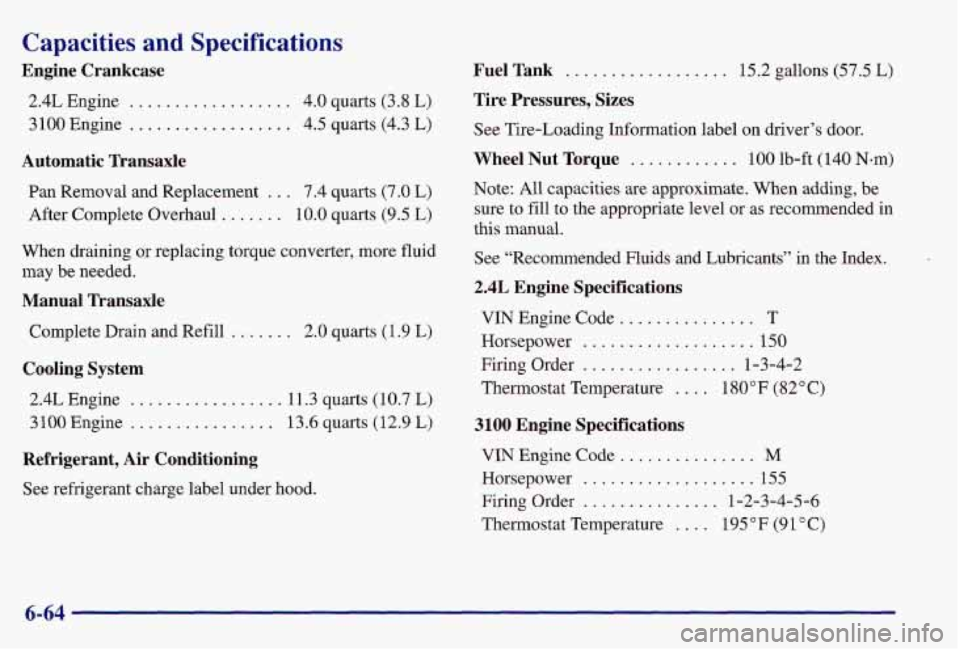
Capacities and Specifications
Engine Crankcase
2.4L Engine . . .......
3 100 Engine .............
. 4.0 quarts (3.8 L)
. 4.5 quarts (4.3 L)
Automatic Transaxle
Pan Removal and Replacement ... 7.4 quarts (7.0 L)
After Complete Overhaul
....... 10.0 quarts (9.5 L)
When draining or replacing torque converter, more fluid
may be needed.
Manual Transaxle
Complete Drain and Refill ....... 2.0 quarts (1.9 L)
Cooling System
2.4L Engine . .... ..... 11.3 quarts (10.7 L)
3100 Engine ................ 13.6 quarts (12.9 L)
Refrigerant, Air Conditioning
See refrigerant charge label under hood.
Fuel Tank .........
Tire Pressures, Sizes
....... 15.2 gallons (57.5 L)
See Tire-Loading Information label on driver’s door.
Wheel Nut Torque ............ 100 lb-ft (140 Nem)
Note: All capacities are approximate. When adding, be
sure to fill to the appropriate level
or as recommended in
this manual.
See “Recommended Fluids and Lubricants” in the Index.
2.4L Engine Specifications
VIN Engine Code ........ __. T
Horsepower ................. 150
Firing Order ................. 1-3-4-2
Thermostat Temperature
.... 180°F (82 O C)
3100 Engine Specifications
VIN Engine Code ........ ... M
Horsepower ..... ... 155
Firing Order
............... 1-2-3-4-5-6
Thermostat Temperature
. . 195°F (91°C)
6-64
Page 294 of 371
7 Section 7 Maintenance Schedule
This section covers the maintenance required for your Pontiac. Your vehicle needs these services to retain its safety,
dependability and emission control performance.
7-2
7-2
7-3
7-4 7-4
7-4
7-7
7-29
7-4
1
7-41 7-41
7-42 Introduction
Your Vehicle and
the Environment
How This Section is Organized
Part A: Scheduled Maintenance Services
Using Your Maintenance Schedule
Selecting the Right Schedule
Footnotes Footnotes
Part
B: Owner Checks and Services
At Each Fuel Fill
At Least Once a Month
At Least Twice a Year 7-42
7-45
7-45
7-45
7-45
7-45
7-46
7-46
7-47 7-49 At
Least Once a Year
Part
C: Periodic Maintenance Inspections
Steering, Suspension and Front Drive
Axle Boot and Seal Inspection
Exhaust System Inspection Radiator and Heater Hose Inspection
Throttle Linkage Inspection
Brake System Inspection Caliper/Knuckle Maintenance Inspection
Part
D: Recommended Fluids and Lubricants
Part
E: Maintenance Record